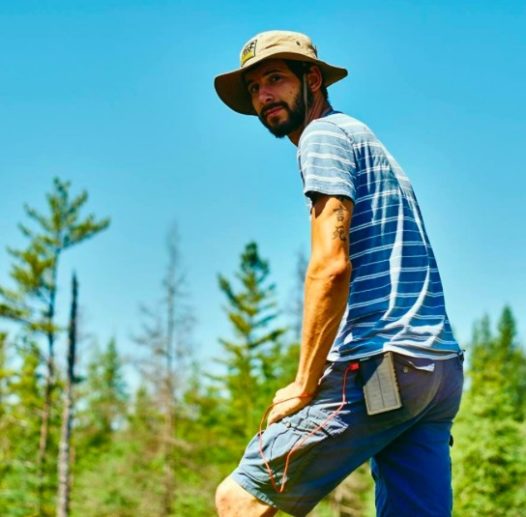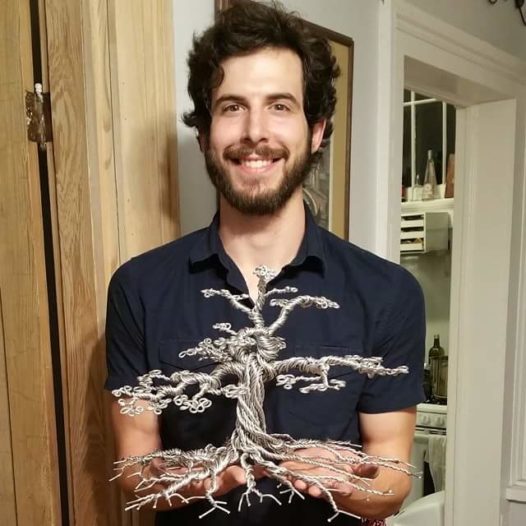
Taylor Williams (Photo by: Mark Reynolds)
Who: Taylor Williams
What: Landscape horticulturist and wire sculptor
Where: Uptown
Artists location for Interview: He didn’t really get to choose since we recorded at WWNO, but we made the best of the small studio
Q: What’s the worst skin reaction you’ve ever had when out in nature?
A: I’ve gotten stuck by thorns so many times — in the head or in the neck, but that’s pretty normal. You would think that the worst would be from a trip out in the woods or some huge wilderness adventure, but it was actually when I was transplanting my grandmother’s Camellia bush.
I was hand-digging the the root ball in Shreveport, Louisiana. It was in the corner of a chain-link fence, and there was this vine growing on it that I didn’t really recognize. I really wasn’t paying attention to the vine, that was more of what it was.
Well, it was poison ivy.
So I was kind of pushing the vine out of the way and not paying it any mind. I had never had any contact with poison ivy before, so I got it pretty bad. It was all over my hands and my arms, but then it just kept spreading.
I don’t worry so much about coming into contact with plants, but I do worry more about ingesting certain things. We have a lot of really poisonous plants around the city. One of the most poisonous plants — of all plants — is oleander, and we have it planted all over New Orleans. It’s on neutral grounds all over the city, and just a few leaves could easily kill someone or a pet.
The thing is, oleanders are really beautiful plants. They’re low-maintenance and drought resistant, so they’re a really easy plant to use. I haven’t ingested that, luckily.
I haven’t really had a bad situation since the poison ivy situation. Not that you need a worse one than that.
Although, even thought I got poison ivy, I managed to transplant a 70+ year old Camellia. It brought some much joy to my Mema that we could keep this family heirloom. She purchased it at age 16. We ended up renting a U-haul and having an arborist put in in back, with basically a large backhoe. The clay root ball made it several hundred pounds. Proud to say it is doing well in River Ridge almost two years later. The same can be said for several Crinum Lilies, which have multiplied. I also managed to root a few cuttings from her fig trees. Gotta keep those in the family.

Taylor Williams with wire sculpture
Q: What song goes through your head while you’re working outside?
A: Unfortunately, it’s usually some top 40 song that gets stuck in my head. After repeating it however many times, I have to ask myself, ‘Why is this in my head? Why am I singing this?’
It’s usually a rap song, which seems like it wouldn’t be so bad, but it’s often the most ridiculous lyric from the song or something that I don’t relate to personally. By the end of the day I can’t help but wonder if I’m programming my brain by singing the lyric and if this repetition of the song is some kind of self-fulfilling prophecy.
Q: From the perspective of a plant and yourself, what is your favorite season in New Orleans?
A: Well, for plants I would say it’s spring because everything is just waking up and having sex. I mean, who doesn’t like that? [Laughing]. But yeah, there are lots of flowers and fresh foliage.
For myself, I’d say fall. I feel like fall has always been a time of change for me. It’s a really symbolic season. The trees let go of their leaves, and we start to shed these different ideas or different habits. At least, that’s been my experience during that time of the year. I always feel really motivated during the fall; although last year the fall was really hot. I mean, it was 85 degrees around Christmas.
And fall is also the best time to plant trees or shrubs. It’s the time for peek root growth. Plus, plants are starting to go dormant, so you don’t have to water them as much, and they don’t experience the shock that they typically would when being transplanted.
Although, planting in the winter is also great — that’s something you really can only say in the south.
Q: What is one of your favorite stories or myths around a plant that’s native to New Orleans?
A: There’s a couple I could think of, but I guess the yaupon holly or Ilex Vomitoria comes to mind. It’s a native species and is naturally occurring in almost all the parishes around the state.
It was used by Native Americans. They would make a tea that they could purge themselves with, hence the name ‘vomitoria.’ From what I’ve been told, the Native American men would drink this tea before getting ready for war to prove or distinguish themselves. It would show that they were ready for battle and ready to be a warrior.
I haven’t had this tea yet, but I’ve heard that if you tone it down a little bit that it’s actually caffeinated, and you won’t necessarily vomit.
Although, I could go full force and do a serious cleanse.
Q: What’s one tool that you cannot live without?
A: I’ve told this to people several times before. If I had only the clothes that I’m currently wearing — nothing else to my name — and I was dropped off in a city, if I had a pair of pruning shears I could make something happen. I could survive and make a living if I just started with a pair of pruning shears.
So many times I see people’s yards that are overgrown, and that’s just opportunity. You have cat’s claw and all these invasive vines that can take over. Although, I have to say, when I go up to someone’s yard and see torpedograss I have this ‘oh no’ moment.
Some people claim that an army corps of engineers brought torpedograss in as a bank stabilization species to prevent erosion. It grows in the spillway sand, so a lot of times new homes are built up with spillway sand, so in a lot of places the torpedograss is everywhere.
I’ve even heard of people basically nuking their yard, and the grass grows right back. It’s grown up around shrubs in commercial spaces so it makes the shrub look like a chia pet. It won’t stop once it starts. You can even dig a few feet down to remove it, and it will still come back. It’s resilient, just like the people that live here. So those shears are important in this state.
I tend to walk around yards and such with pruning shears in my back pocket, which is heavily discouraged by people because they’re afraid you’re going to sit on them. Luckily I’ve never had a self-inflicted wound by them.
I mean, you can’t go into a nightclub with pruning shears or anything, but having a pair on hand is a great idea.
You can see Taylor William’s work throughout New Orleans, and you can also check out his work through Will Garden LLC. Be on the lookout for his full interview, which will be airing on WWNO (89.9) and here on NolaVie.
 NOLAbeings Multimedia artist Claire Bangser created NOLAbeings as a portrait-based story project that marries...
NOLAbeings Multimedia artist Claire Bangser created NOLAbeings as a portrait-based story project that marries...  Voodoo in New Orleans: Reviving history: New Orleans fortune telling This article takes a deep dive into the history of Voodoo in New Orleans, its hybridization with Catholicism, and its present-day place in the city's culture. The author visits fortune-tellers in the French Quarter, using their guidance as a tool for introspection rather than a deterministic predictor of the future. Through her experiences in New Orleans, the author feels a mystical connection to both the past and the future.
Voodoo in New Orleans: Reviving history: New Orleans fortune telling This article takes a deep dive into the history of Voodoo in New Orleans, its hybridization with Catholicism, and its present-day place in the city's culture. The author visits fortune-tellers in the French Quarter, using their guidance as a tool for introspection rather than a deterministic predictor of the future. Through her experiences in New Orleans, the author feels a mystical connection to both the past and the future. 